از درخواست شما به دلیل تاخیر در پاسخ اجتناب کنید، لطفا واتساپ/وی چت/اسکایپ خود را همراه با پیام وارد کنید تا بتوانیم در اولین بار با شما تماس بگیریم.
ما ظرف 24 ساعت به شما پاسخ خواهیم داد. اگر برای موارد فوری، لطفا WhatsApp را اضافه کنید: +86 17864107808، یا WeChat: +86 17864107808. یا تماس بگیرید +86 17864107808 مستقیما
*ما به محرمانه بودن شما احترام می گذاریم و تمام اطلاعات محفوظ است. ما فقط از اطلاعات شما برای پاسخ به درخواست شما استفاده می کنیم و هرگز ایمیل های ناخواسته یا پیام های تبلیغاتی ارسال نمی کنیم.
I often see people confused about printer options. They wonder if a wireless inkjet printer is right for them. I want to share simple facts now.
A wireless inkjet printer is an ink-based device that connects to a network without cables. It prints vibrant images and text using tiny droplets of ink. It is popular for convenience and flexibility.
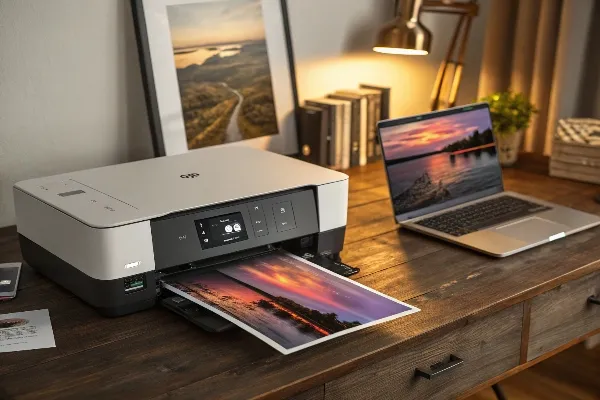
I remember my first time setting up a wireless printer at my office. It saved space, and it also let me print from many devices. Now, I want to explain why others might consider these printers and how they compare to other options.
I see people hesitant when I mention wireless printers. They worry about signal issues or setup challenges. I want to explore these concerns.
Wireless printers can suffer from slow speeds if your network is weak. They might also need extra security measures to protect data transfers. They rely on a stable Wi-Fi connection.

I notice that some users find wireless printers harder to troubleshoot than wired models. Network interference can disrupt printing. In my experience, these problems appear most often in busy environments with multiple devices. Wireless printers also require secure connections because sensitive data can travel through the network. When I tried to print large files at a crowded event, the process sometimes paused or slowed. That made me realize that reliable Wi-Fi is essential.
| نقطه ضعف | توضیح |
|---|---|
| Network Interference | Signals can drop if many devices share one network. |
| Security Risks | Data might be vulnerable without proper encryption protocols. |
| Setup Complexity | Some routers or firewalls need manual configuration for smooth printing. |
| Possible Speed Issues | Large image files can stall if Wi-Fi strength is weak. |
I want to examine these problems in a straightforward way. A wireless printer is convenient, but it needs a stable connection to perform well. If Wi-Fi coverage is weak, pages might fail to print. Security can be another big worry. Unauthorized access can happen if the wireless connection is not protected with robust passwords or secure encryption. Also, I have seen issues with driver updates. Some operating systems need frequent patches, which can disrupt printing if not kept current. All these disadvantages highlight the importance of careful setup and monitoring. I do not want to dissuade anyone from using a wireless printer, but I think it is wise to plan for good Wi-Fi coverage, secure networks, and updated drivers. In my own office, I added a dedicated router to handle the workload. That minimized the risk of dropouts and kept print jobs on track. I suggest that anyone who needs reliability or high-volume output should look at these factors and decide if a wireless printer is the best fit.
Sometimes I hear people ask what separates an inkjet printer from “regular” ones. They wonder if there is an actual distinction. I think it is worth clarifying.
Inkjet printers spray microscopic droplets of ink onto paper. Regular printers, such as laser printers, use toner and heat. Inkjet models often excel at photo and color output.
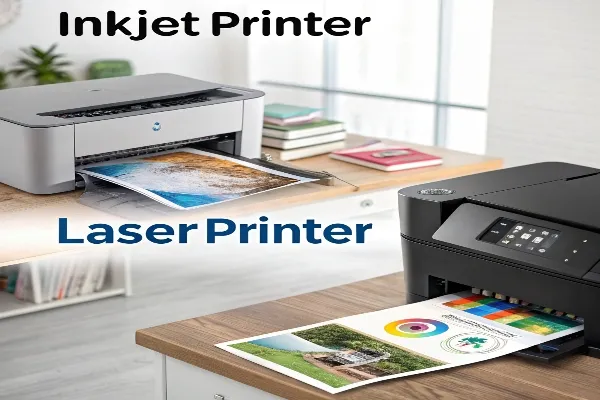
I want to break down the differences in a simple way. Inkjet printers rely on ink cartridges that create images by ejecting precise droplets. Laser printers, which many people call “regular” printers, fuse powdered toner onto paper using a heated drum. I have used both. I see that inkjet printers usually cost less upfront, but they might need more frequent cartridge changes. Laser printers might cost more initially, but they are often faster and handle high-volume tasks well.
| نوع چاپگر | روش چاپ | Typical Use Case | Maintenance Needs |
|---|---|---|---|
| جوهر افشان | Sprays liquid ink droplets onto paper | Photos, color documents, home usage | Regular cartridge changes |
| Laser (Regular) | Uses toner powder and heat to fuse onto paper | Office documents, fast production | Occasional toner refills |
I recall times when I preferred my inkjet printer for vibrant color prints. It let me produce high-quality photos with deep tones and smooth gradients. On the other hand, my neighbor, who runs a small office, relies on a laser printer for large document runs. Speed and cost per page are vital for him. He needs hundreds of pages printed daily with consistent text clarity. The difference also shows in print longevity. Laser prints are often more resistant to smudges and fading. Meanwhile, certain inkjet prints can smudge if the paper is not suitable or if the ink is not fully dried. I learned that the final choice depends on usage needs and desired results. If someone needs bright, photo-realistic output at a moderate volume, an inkjet printer makes sense. If they need fast and clean text for high-volume jobs, a laser printer might be the better option. In my view, the biggest factor is how often you print and what kind of images or documents you produce. Because I like to work on packaging prototypes with bright designs, I often lean toward inkjet technology.
People often ask me about downsides of inkjet printers. They hear that inkjets create rich, colorful images, but they want to know about potential problems.
Inkjet printers can have higher ink costs over time. They also print slower than some laser printers. They need specialized paper for best results.
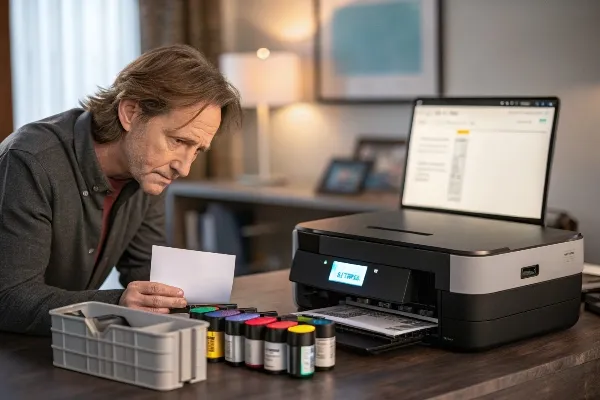
I see that some inkjet models come with expensive replacement cartridges. In my experience, those costs add up quickly if you print frequently. I remember a busy month when I printed marketing materials. I had to swap ink cartridges more than expected, and it strained my budget. Laser printers usually offer lower cost per page, especially for text-heavy documents.
| نقطه ضعف | توضیح |
|---|---|
| Higher Ongoing Costs | Ink cartridges can be pricey, especially for color printing. |
| Slower Printing Speed | Many inkjets take more time to produce large batches of documents. |
| Possible Ink Drying Issues | If unused for a while, ink can dry and clog the nozzles. |
| Paper Sensitivity | Some papers can cause smudging if not compatible with inkjet technology. |
I also notice that inkjets might clog if not used regularly. Dried ink can cause streaks or missing colors. This problem is often resolved by running printhead cleaning cycles1, but that uses more ink. I used to store my printer in a dusty area, and I found that the nozzles got clogged more often. That taught me to keep the printer clean and in a stable environment. Another disadvantage is that inkjet printers might not match the speed of laser models for high-volume text printing. When I tried to print large documents for a workshop, the inkjet printer took a long time. That bothered me because I wanted to distribute the materials on time. On top of that, certain inkjet prints are more vulnerable to water damage. The prints can smudge if they get moist. To address this, I started using quick-drying inks or special paper coatings. These steps helped, but that required extra effort. All of these points lead me to believe that inkjet printers are ideal for creative projects, short runs, or photo printing. They offer rich color. However, they might not be the top choice for heavy text-based printing or fast production environments. People need to weigh these pros and cons before deciding.
I often hear this question from people who are new to printing. They wonder if they can skip buying ink or if they can operate the printer with just black cartridges.
Yes, an inkjet printer relies on ink cartridges for operation. It needs the correct color or black cartridges to print images or text.
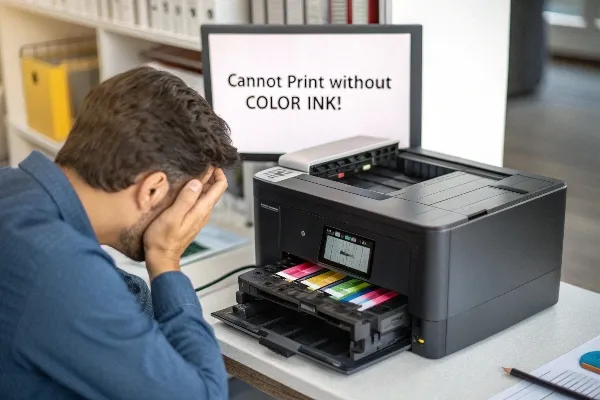
I remember the first time I tried to print a color photo without having all color cartridges. My printer refused to proceed. Many inkjet models need every color cartridge installed, even if I only want black text. That is because the printer often uses small amounts of color ink for cleaning tasks or to enhance black shades. If the color cartridge is empty, some printers will not function. This can be frustrating for those who want to save money by only using black ink. Also, ink quality is crucial. Cheap, third-party refills might cause color accuracy problems or clog the printhead. I once bought a low-cost refill that ended up leaking, which stained the inside of the printer. That was a bad day. Now, I use compatible but reliable brands that have good reviews. Regular ink is also necessary for maintenance cycles. Inkjet printers run automated cleaning and priming routines. Those routines use small amounts of ink to keep nozzles clear. This means that even if you rarely print, you might notice ink levels dropping over time. If you plan to print high-quality graphics, I recommend looking at printers with large-capacity tanks or cost-efficient refill methods. Some newer models feature ink tank systems that can reduce the cost of printing in the long run. In the end, ink is central to the function of an inkjet printer. Without it, the printheads cannot create images or text. That is why it is called an inkjet printer.
People sometimes ask me about different inkjet categories. They assume all inkjets are the same, but there are actually two main types worth noting.
The two main types of inkjet printers are continuous inkjet1 و drop-on-demand inkjet2. Continuous inkjet sprays ink constantly, while drop-on-demand releases ink only when needed.
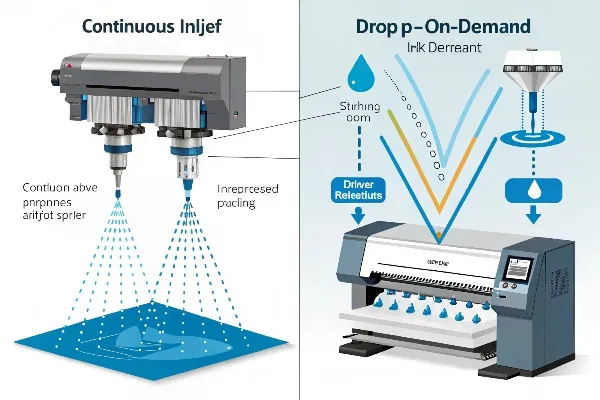
I often see confusion about these two types. Continuous inkjet printers are common in industrial or packaging settings. They use a stream of ink that moves through a nozzle at high speed. A part of the ink is directed onto the substrate, while the remainder is recycled. Drop-on-demand inkjet printers are found in most home and office environments. They release ink droplets only when a printhead signals that it is time to print. This technology is common in consumer printers, because it reduces waste and allows for high resolution. I discovered this distinction when I worked on packaging prototypes. We needed a continuous inkjet printer for codes and batch numbers. It was faster for printing small text on boxes. At home, I rely on a drop-on-demand printer for photos and documents.
| Type | Key Feature | Common Use Case |
|---|---|---|
| Continuous Inkjet | Constant ink stream, some ink gets recycled | High-speed industrial coding |
| Drop-On-Demand | Only ejects ink droplets when printing is required | Standard home, office, and creative |
Continuous inkjet printers also handle a wide range of substrates, including curved or flexible surfaces. That is important for packaging lines that move quickly. I remember seeing a continuous inkjet system in a factory that stamped date codes on plastic bottles. It had to keep up with a fast assembly line. Drop-on-demand models, on the other hand, might pause between pages and print heads. They can produce detailed color photos with minimal overspray. This method is more precise for designs that need accurate color placement. If you want an everyday printer for documents, you likely use drop-on-demand technology. This approach helps save ink and produces crisp images. If your business needs a robust solution for packaging or labeling, continuous inkjet might be the right tool. Both systems depend on stable hardware, but they serve different purposes. I like drop-on-demand for my creative work, because I want to be in control of each droplet. That level of detail matters when I print sample packaging for clients. Meanwhile, continuous inkjet remains a strong choi
I think a good printer decision comes from understanding your real needs. Different features lead to very different outcomes. Choose what works best for you.